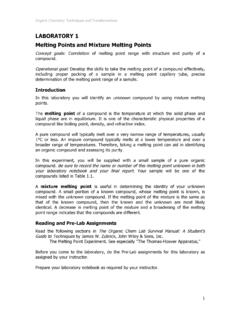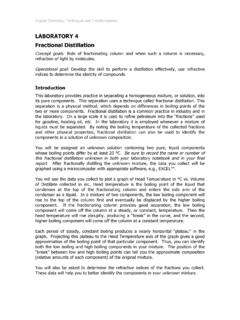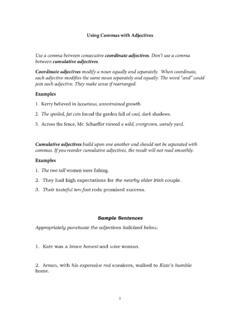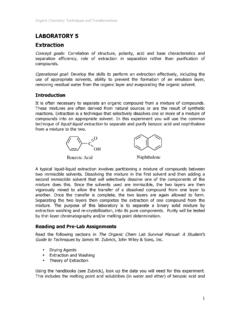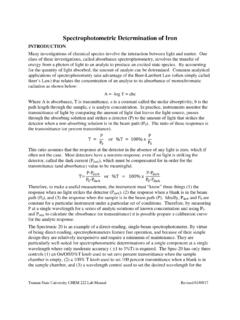Transcription of Spectrophotometric Analysis: Determining the Iron …
1 Spectrophotometric analysis : Determining the iron Content in Supplements OBJECTIVE: The goal of this experiment is to use the quantitative technique of spectrophotometry to determine the mass of iron contained in a commercially available supplement tablet. SKILLS: Using a spectrophotometer; preparing a standard curve, serial dilutions EQUIPMENT: SpectroVis spectrophotometer, mL volumetric pipettes, and mL volumetric flasks SAFETY AND DISPOSAL: Any solution containing the red Fe 1,10-phenanthroline complex should be disposed of in the appropriately labeled container. All other waste can be disposed of down the drain. INTRODUCTION: iron is the fourth most abundant element in the earth s crust and is an important component in many biological systems. The fact that iron has two readily accessible oxidation states, Fe+2 and Fe+3, also contributes to its usefulness as an active component of proteins.
2 The average adult human body contains 4 6 g of iron . In human beings, the majority of iron present is found in the blood protein hemoglobin. The function of this protein is to transport oxygen from the lungs to the various tissues in the body where it is used to produce energy. One of the byproducts of this metabolism, carbon dioxide, is then transported back to the lungs by hemoglobin. Humans obtain the iron necessary for the formation of hemoglobin from their diet in foods such as meat and leafy, green vegetables. When the dietary intake is deficient in iron , a condition called anemia results. Someone who is anemic exhibits a lack of energy and often unusually pale skin tone (the red color of blood is also a result of the presence of iron in hemoglobin). Dietary supplements of iron in the form of vitamin tablets can be administered to help alleviate this condition.
3 iron supplements contain iron in a variety of compounds: ferrous fumarate, ferrous sulfate, and ferrous gluconate. Notice that all of these compounds contain Fe+2 (ferrous) because Fe+3 can be toxic and is less soluble the Fe+2. Spectrophotometery One of the most common techniques used in the quantitative analysis of samples for a specific chemical substance is called spectrophotometry. Using this technique, the amount of light absorbed by a sample is measured with an instrument called a spectrophotometer, and this absorbance is proportional to the concentration of the species being analyzed. The relationship between absorbance, A, and concentration, c, is known as the beer -Lambert law: A= lc where l is the path length, or the distance the light travels through a sample, usually expressed in cm, and is the molar absorbtivity, or simply a constant of proportionality.
4 For most experiments, the path length is fixed and thus the relationship simplifies to: A=kc where k is a constant the needs to be determined experimentally. The concentration can be expressed in any convenient unit such as molarity, mg/mL, parts per million (ppm), etc. In order to determine the concentration of an unknown solution using this technique, a series of solutions of known concentration, or standards, need to be prepared and analyzed. Using the standards, a standard or calibration curve is constructed by plotting the absorbance of the standards versus the known concentrations. A line is fit through this data and the resulting equation can be used to convert the absorbance measurement of an unknown to the concentration of the unknown. The concentrations of the standard solutions are chosen to produce a range in absorbance that will include the absorbance of the unknown.
5 If the absorbance of an unknown falls outside the range of the standards, then either the unknown needs to be diluted further (if the absorbance is too high) or a new set of standards need to be prepared with a more appropriate ranges of concentrations (if the absorbance of the unknown is too low). analysis of iron In this experiment, you will spectrophotometrically analyze a commercially available vitamin supplement in order to determine the quantity of iron that is contained in the tablet. To do this, the iron will first be converted into a form that absorbs radiation in the visible region by reacting it with an organic compound called 1,10-phenanthroline. The structure of this molecule is shown in Figure 1. It reacts with Fe+2 to form a complex that contains one iron ion and three 1,10-phenanthroline molecules (the structure of this compound is shown in Figure 2).
6 The color of this compound in solution is bright red-orange and it absorbs light very strongly in the visible region at a wavelength of 508 nm. 1,10-phenanthroline will be reacted with a vitamin tablet that has been digested in hydrochloric acid. In order for this reaction to occur to produce the colored complex, the iron ions must be in the Fe+2 oxidation state. Since Fe+2 is easily oxidized to Fe+3 in the presence of acid and water, a reducing agent called hydroquinone is added to the solution. In addition, it is important that the acidity of the solution is carefully controlled or the Fe-1,10-phenanthroline complex will not form. The addition of sodium citrate in solution will neutralize some of the acid and maintain the proper pH. Figure 1: The structure of 1,10-phenanthroline The resulting solution will be diluted to an appropriate concentration and its absorbance measured.
7 Using data collected from a series of solutions of known concentration a standard curve will be constructed. The concentration of iron in your sample solution, and thus the amount of iron contained in the vitamin tablet, can subsequently be calculated. Figure 2: The structure of the iron -1,10-phenanthroline complex Concentration units and dilutions Up until this point the main unit of concentration that we have employed has been molarity, or moles per liter. This unit is very helpful in dealing with chemical reactions and stoichiometry. However, there are several additional units that may prove useful in certain situations. For example, in this experiment mass per volume will be used to describe the concentration of solutions. This will enable the determination of the mass of iron in the vitamin supplement tablet.
8 In analytical chemistry the unit of parts per million is also used frequently. For aqueous solutions the conversion factor between ppm and mg/L is: 1 ppm = 1 mg/L. During the course of this experiment you will need to do several dilution calculations. In general, the following relationship can be applied for dilution calculations with any concentration unit: c1V1 = c2V2 where c represents the concentration of solutions 1 and 2 in the same concentration unit and V represents the volume of solution 1 and 2 in the same volume units. For example, if you take 10 mL of a solution that has an iron concentration of 1 mg/mL and dilute that to a total volume of 100 mL you can determine the concentration of the dilute solution using the above expression since c1 = 1 mg/mL, V1 = 10 mL, V2 = 100 mL, and c2 is the unknown concentration of the dilute solution that you are solving for.
9 Putting this together and solving for c2: c2=c1V1V2=(1 mg/mL)(10 mL)100 mL= mg/mL You will be performing serial dilutions during this experiment and you will have to perform this calculation several times. EXPERIMENTAL PROCEDURE This is a quantitative experiment, so it is very important that you work carefully and consistently throughout. Some general things to keep in mind: 1. Remember that it is good, standard chemical practice to pour small portions of reagents for your use from the stock bottles. Do not risk contaminating the stock bottles by inserting pipettes or other glassware. Also, NEVER pour unused reagents back into a stock bottle. 2. For all volume measurements of Fe-containing solutions you must use volumetric pipettes. These pipettes are designed to deliver the volume specified and only that volume.
10 When using these pipettes DO NOT blow out the last bit of liquid from the tip. Each pipette is calibrated to deliver (TD) exactly the specified volume from the line to where the liquid naturally stops draining. 3. All other reagents are used in excess, so the volumes do NOT need to be measured carefully. You may use clean disposable plastic pipettes or clean graduated cylinders to measure the volumes of other solutions ( that are not Fe-containing). 4. When using a volumetric flask, the specified volume is achieved by having the bottom of the meniscus level with the line on the flask. If the liquid level exceeds the line, that solution must be discarded and prepared again. Therefore, it is useful to add water slowly with a dropper as you approach the line. You will need three 100 mL volumetric flasks for this experiment.

